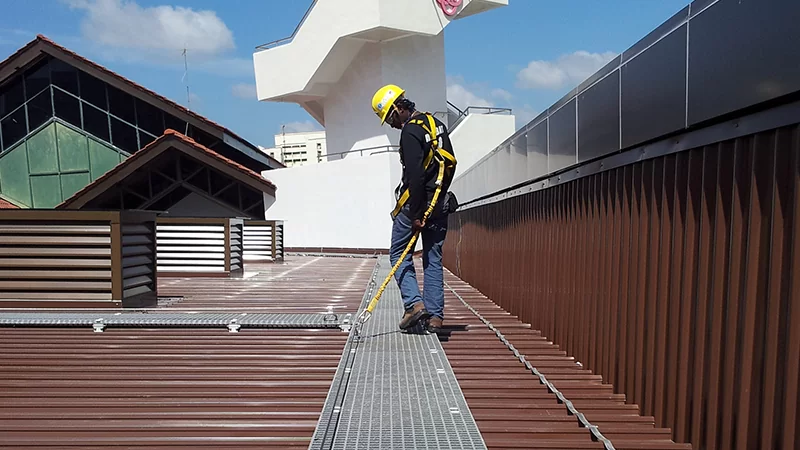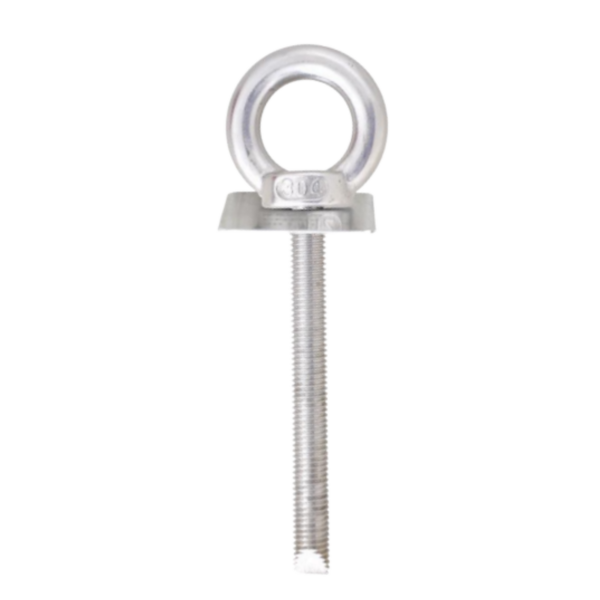Understanding the Edge Stainless Steel M16 Concrete Anchor Point
The Edge Stainless Steel M16 Concrete Anchor Point represents a benchmark in safety and engineering precision. Designed for demanding environments, it serves as a dependable anchorage solution for professionals working at height or in areas requiring solid structural attachment. The M16 classification indicates its size and thread dimension, ensuring compatibility with a wide range of fall protection systems and lifting equipment. What sets it apart is the balance between strength, corrosion resistance, and ease of installation. Whether applied in commercial buildings, bridges, or industrial towers, this anchor point delivers confidence and stability. It is engineered to maintain its structural integrity under high stress, providing lasting protection even in harsh weather or heavy-duty use. For safety engineers and construction professionals, this component has become a vital element in ensuring worker safety and structural reliability.
The Importance of Using High-Quality Stainless Steel in Anchor Systems
Selecting stainless steel for anchor points is a strategic choice that goes beyond aesthetics—it’s about performance and safety assurance. Stainless steel offers superior resistance to corrosion compared to galvanized materials, making it ideal for environments exposed to moisture, chemicals, and salt. This ensures the Edge Stainless Steel M16 Concrete Anchor Point retains its strength and reliability even after years of exposure. Beyond durability, stainless steel maintains consistent load-bearing capacity under varying temperatures and stress levels. It prevents premature wear, reducing the frequency of replacements and minimizing downtime. For projects located in coastal areas or industrial zones, this material ensures a longer service life and lower maintenance costs. Ultimately, using stainless steel reflects a commitment to safety, cost-effectiveness, and compliance with international safety standards.
Technical Specifications of the M16 Concrete Anchor Point
The M16 specification is central to the product’s design. The “M16” denotes a 16-millimeter diameter threaded bolt, which fits securely into pre-drilled holes in concrete structures. This dimension ensures optimal strength and load capacity suitable for demanding applications. The Edge Stainless Steel M16 Concrete Anchor Point typically supports heavy loads, meeting or exceeding international safety benchmarks such as EN, ANSI, and OSHA standards. Manufacturers also specify torque values for installation, ensuring the anchor point is secured correctly without damaging the concrete substrate. The combination of stainless steel composition and precise threading results in a robust connection that resists shear and tension forces. It’s also engineered for versatility, making it suitable for single-user applications, lifeline systems, or as a fixed anchor for access equipment. Each anchor undergoes quality testing to verify strength, elongation, and surface finish, ensuring performance consistency across batches.
Installation and Mounting on Concrete Structures
Installing an Edge Stainless Steel M16 Concrete Anchor Point requires careful attention to detail. The process begins by drilling a hole into the concrete surface, ensuring the diameter and depth align with the manufacturer’s recommendations. Proper cleaning of the hole is crucial to remove debris and ensure maximum adhesion and friction. Once positioned, the anchor is tightened to the specified torque using a calibrated wrench. Over-tightening or under-tightening can compromise its performance, which is why professional installers follow precise procedures. Regular inspection during installation verifies correct placement and alignment. To ensure longevity and security, installers should adhere to these essential steps:
- Measure and mark exact hole placement before drilling.
- Clean the drilled hole thoroughly to remove dust or debris.
- Insert the M16 anchor using appropriate sealing or locking mechanisms.
- Torque the bolt according to manufacturer standards.
- Inspect alignment and test the anchor’s stability after installation.
This method ensures a strong, reliable attachment that meets safety compliance and engineering standards.
Applications in Height Safety and Structural Engineering
The Edge Stainless Steel M16 Concrete Anchor Point serves as a key component in height safety systems and structural engineering solutions. It acts as a critical connection point for fall protection systems, allowing workers to attach harnesses, lanyards, or lifelines securely. Common applications include façade maintenance, rope access operations, and window cleaning on high-rise structures. Engineers also integrate these anchor points into construction scaffolding, communication towers, and infrastructure projects like bridges and wind turbines. They provide an essential link between personnel and safety equipment, reducing the risk of accidents in elevated work environments. Additionally, these anchor points are used in structural reinforcement and heavy-load applications, ensuring stability during high-stress operations. Their adaptability makes them suitable for both permanent and temporary installations, aligning with industry demands for flexible and durable safety solutions.
Testing, Certification, and Compliance Standards
Every Edge Stainless Steel M16 Concrete Anchor Point undergoes rigorous testing and certification to meet global safety regulations. Compliance with standards such as EN 795, OSHA 1910, and ANSI Z359 ensures that each product meets the highest quality benchmarks for fall protection and anchorage performance. Load testing evaluates the anchor’s ability to withstand tension and shear forces, while material testing confirms corrosion resistance and metal integrity. Manufacturers also perform cyclic testing to ensure the anchor maintains performance under repeated stress. Certification not only verifies product reliability but also simplifies compliance for contractors and building owners. By selecting certified anchors, project managers demonstrate adherence to safety legislation and industry best practices. Regular third-party audits and traceability measures further enhance quality assurance, offering end users confidence in both safety and performance.
Maintenance, Inspection, and Lifespan
To ensure consistent performance, regular maintenance and inspection of M16 anchor points are essential. Stainless steel may resist corrosion, but periodic cleaning helps prevent buildup of dust, grime, or chemical residue. Inspectors should check for any signs of wear, bending, cracks, or surface discoloration, which could indicate stress or improper installation. Depending on usage frequency and environmental conditions, inspections are typically conducted every six to twelve months. Maintenance involves light cleaning with non-abrasive materials and applying protective coatings if necessary. Documentation of inspections supports compliance with OSHA and other safety standards. With proper care, the Edge Stainless Steel M16 Concrete Anchor Point can last for many years, maintaining its mechanical strength and protective capabilities. This longevity contributes to cost savings and sustained reliability over the lifespan of a building or structure.
Benefits of Choosing Edge Stainless Steel M16 Concrete Anchor Points
Choosing the Edge Stainless Steel M16 Concrete Anchor Point offers multiple advantages for safety and operational efficiency. It combines durability, versatility, and high performance in one compact unit. The anchor point resists corrosion and environmental degradation, making it suitable for outdoor and industrial use. Its compatibility with various personal protective equipment (PPE) enhances worker safety and convenience. Key benefits include:
- Exceptional resistance to rust and corrosion
- High tensile and shear strength for demanding applications
- Easy installation on concrete surfaces
- Long service life with minimal maintenance
- Compatibility with multiple fall protection systems
These benefits make it an excellent investment for companies that prioritize safety and long-term value.
Factors to Consider When Selecting the Right Anchor Point
Selecting the appropriate anchor point involves understanding the specific requirements of your project environment. Factors such as load capacity, environmental exposure, and compatibility with existing safety systems must be evaluated. The Edge Stainless Steel M16 Concrete Anchor Point offers options that cater to varied conditions—whether in coastal environments, chemical plants, or construction sites. Other factors include the accessibility of mounting locations and the ease of inspection. Evaluating these aspects helps ensure that each installed anchor point delivers maximum safety and functionality. It’s also important to source from reputable manufacturers to guarantee compliance and quality. Making the right selection directly affects the safety of workers and the success of the entire project.
Real-World Use Scenarios
Across industries, the Edge Stainless Steel M16 Concrete Anchor Point has proven indispensable in real-world applications. Construction companies rely on it for high-rise projects where workers need dependable fall arrest systems. Maintenance teams use it for façade cleaning and window repair in tall buildings. In industrial sectors, it supports workers in refineries, energy plants, and storage facilities. Engineers appreciate its versatility for both temporary and permanent installations. It also plays a key role in bridge construction and offshore projects, where environmental exposure demands high durability. These scenarios highlight its adaptability and effectiveness in ensuring worker safety and project integrity under various conditions.
Best Practices for Worker Safety and Compliance
Ensuring worker safety extends beyond installing quality equipment—it involves training, documentation, and adherence to compliance protocols. Workers must be trained in proper anchorage usage, including how to connect harnesses and inspect anchor systems. Routine documentation of inspections helps verify safety compliance and identify maintenance needs early. Collaboration with certified safety equipment providers ensures compatibility and performance. Regular audits help maintain workplace safety standards and foster a culture of awareness and accountability. When paired with personal protective equipment, the Edge Stainless Steel M16 Concrete Anchor Point becomes part of a complete, effective fall protection strategy that prioritizes worker wellbeing.
Frequently Asked Questions (FAQ)
What does M16 mean in anchor points?
M16 refers to the diameter and thread size of the anchor bolt, measuring 16 millimeters. This specification ensures strength and compatibility with standard hardware and safety systems.
Can M16 stainless steel anchors be used outdoors?
Yes. The stainless steel construction provides excellent resistance to rust and corrosion, making it ideal for outdoor and coastal environments.
How much weight can an M16 concrete anchor point support?
Depending on manufacturer specifications, M16 anchors can typically handle loads exceeding several thousand pounds, ensuring secure fall protection.
Are Edge Stainless Steel anchors compliant with OSHA standards?
Yes. These anchors are designed and tested according to OSHA, EN, and ANSI safety standards to meet regulatory requirements.
How long do stainless steel anchor points last before replacement?
With proper installation and maintenance, stainless steel anchors can last for many years, often exceeding a decade in normal working conditions.
Takeaway
The Edge Stainless Steel M16 Concrete Anchor Point is more than just a fastening component—it’s a trusted partner in maintaining safety and structural stability. Its precision design, corrosion-resistant material, and compliance with global safety standards make it an essential element for modern construction and maintenance projects. When chosen and installed correctly, it provides unmatched protection, ensuring every worker at height operates within a secure and dependable system.











